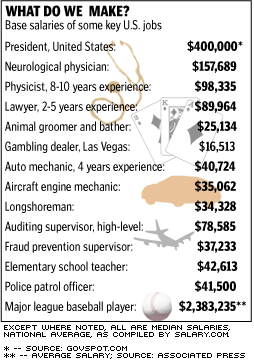NEW YORK (CNN/Money) -
America honors its workers with the annual Labor Day holiday Monday, but parades and picnics won't do much to ease the pain a recession has caused the labor force -- and the unions that started Labor Day likely won't help much, either.
The most obvious problem facing the work force is stagnant job growth. Since March 2001, when a recession in the broader U.S. economy began, nearly 1.7 million jobs have been lost, and more than 3.5 million people are drawing unemployment benefits.
"The impact of the recession, exacerbated by the impact of the events of September 11, has fallen heaviest on working people," the National Association of Manufacturers said in its annual Labor Day Report.
And some economists have noted that this recovery is starting to look an awful lot like the recovery from the 1990-91 recession, when job growth was dead in the water for more than a year, probably costing then-President George Bush his bid for re-election in 1992.

"The job market is going to get worse -- this is a jobless recovery," said Anthony Chan, chief economist at Banc One Investment Advisors, who said he expected the unemployment rate to climb to at least 6.1 percent this year.
And the NAM agreed, saying its survey of manufacturers -- who cut the most jobs during the recession -- found most planned to continue to gradually lower payrolls this year, helping keep the total unemployment rate near 6 percent until 2003.
Though the July unemployment rate of 5.9 percent is low relative to its 10.8-percent peak in 1982 and its 7.8-percent peak in 1992, jobs are still scarce -- non-farm payrolls grew by only 6,000 workers in July, for example, far below the approximately 120,000 jobs economists think are necessary to keep unemployment from rising.
With jobs scarce and corporate profits suffering from a broader economic downturn, not only are the aggressive employee recruitment tactics of the late 1990s long gone, more basic employee perks such as raises and bonuses are also under pressure.
| |
 RELATED ARTICLES
RELATED ARTICLES
| |
| | |
| | |
|
A recent survey by Mercer Human Resource Consulting, for example, found that annual pay raises are becoming a thing of the past, with employers delaying raises for 18 months or more, USA Today reported Friday.
"People think unemployment is still relatively low, but there's all the difference in the world between a tight labor market and a weak one when you're talking about employees' ability to bargain for a fair share of growth," said Jared Bernstein, a labor economist at the Economic Policy Institute.
Twilight of the labor unions
Labor unions, which hosted the first Labor Day celebration in New York City in 1882, could once be relied upon to look out for the interests of many American workers -- up to 35 percent during organized labor's heyday in the 1950s.
And unions have certainly made splashy headlines in the days leading up to Labor Day 2002 -- everybody from baseball players to flight attendants have been wrestling publicly with management.
| |
 Labor strife in the news
Labor strife in the news
| |
| | |
| | |
|
The recent rash of corporate scandals, in which corporate executives have made millions before skipping out, leaving employees holding the bag, it would seem that unions would be as alluring to workers as ever.
"I've been hearing more workers -- including former Enron workers -- say they now wish they'd had a union," John Sweeney, President of the American Federation of Labor and Congress of Industrial Organizations, said at the AFL-CIO's Labor Day Roundtable on Thursday.
But union membership in this country has fallen steadily since the early 1980s; by 2001, only 9 percent of U.S. workers in private industry were unionized.
Ed Potter, President of the Employment Policy Foundation, said unions have failed to dedicate enough resources to organizing and have failed to update their services to compete with other organizations vying for workers' time, such as the NAACP and the AARP. As a result, worker interest in unions has waned.
"If a business is losing market share, it tends to think about what it can do to reinvigorate its product, make it more attractive," Potter said. "Only on the margins has the AFL-CIO done that."
In any event, Potter asserted, workers are not any worse off now than they have been historically -- the boom years of the late 1990s, when unemployment dropped below 4 percent and businesses had to practically beg people to work for them, were an aberration.
Competition for workers led to some excesses in compensation and perks -- pool tables and free meals were just the tip of the iceberg -- which businesses have had to correct after the bubble burst. That correction process could ease up when businesses are convinced the economy is turning around.
"Just as companies are slow to recognize things are going to slow down, they're also slow to recognize that things are going to pick back up," Potter said. "We're in a nether world right now, where companies don't necessarily know what is the correct action to take here -- they don't know whether they should be hiring or whether they should be more cautious about pay increases."

|

